Gather round, friends. Gather round. It’s story time.
It was April 2004. “Yeah!” by Usher was burning up the music charts. People were still reeling about the infamous wardrobe malfunction during the Super Bowl halftime show. And Google released Gmail.
Back then, a gigabyte was a heckuva lot of storage space. And Gmail offered everyone their own precious gigabyte of storage. Hotmail and Yahoo Mail—two big email players at the time—offered mere megabytes.
Thing was: Gmail was released on April 1—April Fools’ Day. As such, thanks in large part to its far-too-generous allotment of space, many people thought Gmail was a hoax. A hoax!
Fast-forward to today, and Gmail gives you 15 GB of storage. It’s . . . eh . . . a fair amount, but it’s no longer revolutionary. And now you have to share those gigabytes with Google Drive and Google Photos.
There’s a good chance that if you use Gmail as your main email service, it’s eating up the lion’s share of those 15 GB. Here are a few ways to clear out the clutter and reclaim some space.
How to check your current storage level
Log into Gmail and scroll all the way to the bottom of your inbox. In the lower-left corner, you’ll see how much storage you’re using compared to how much you have available. If the bar is mostly light gray, good for you; you’ve got plenty of space left. If it’s mostly (or all) black, it’s time to roll up your sleeves.

You’ll notice in this image above that I’m using a whopping 85 GB out of a total of 216 GB available. That brings us to our first tip.
The easy route: pony up for more storage
I’m no digital hoarder; I’m just lazy. As such, I long ago started paying for extra storage from Google so I wouldn’t have to keep pruning my inbox, Drive, and Photos collections.
Google sells storage under the Google One brand. Head to one.google.com/storage and scroll down a bit to see the available plans. For reference, I pay $30 a year for 200 GB.
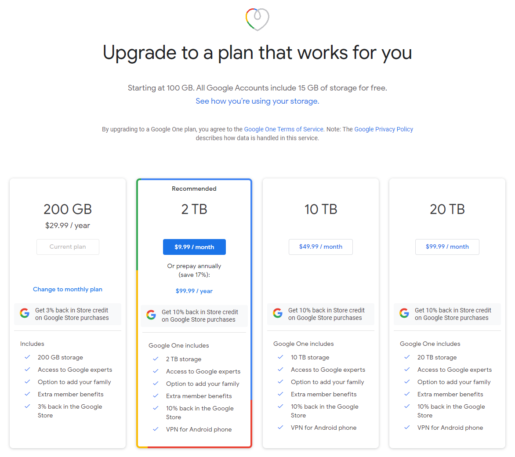
Is it worth it? My brother-in-law was complaining about running out of space the other day, complained further about having to pay for extra space, and then after asking what I paid for my space, paused for a few seconds and finally said, “Damn. That’s pretty much the exact price where it’s a no-brainer.”
If it’s not a no-brainer for you, there are still several ways to free up storage without paying for more.
Clean it up automatically
You can get a good overview of what’s hogging space by visiting the Storage Management page. From there, you can review deleted emails that haven’t yet been expunged, spam, attachments, and other large files.
Click into each section, where you can review the items Google thinks you might want to jettison, and then either delete them one by one or check the “All items” box in the upper-left corner to go nuclear.
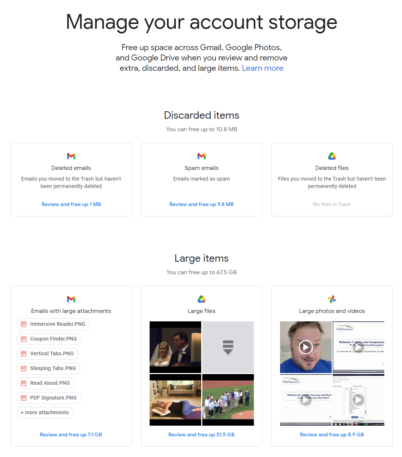
I find the interface for this to be uncharacteristically clunky given Google’s typical UI chops, so let’s move directly over to Gmail to do things a bit more surgically.
Delete large attachments
In Gmail, click the little downward arrow on the far right of the search box to bring up the advanced search menu. Now, there are a bunch of fields we can fill out here, but the one we’re looking for is the “Size field” about halfway down. Let’s choose 15 MB, which kinda-sorta teeters on the edge of being a storage-sucking message.
Click the blue search button and you’ll see a list of all the emails you have with attachments totaling 15 MB or larger.
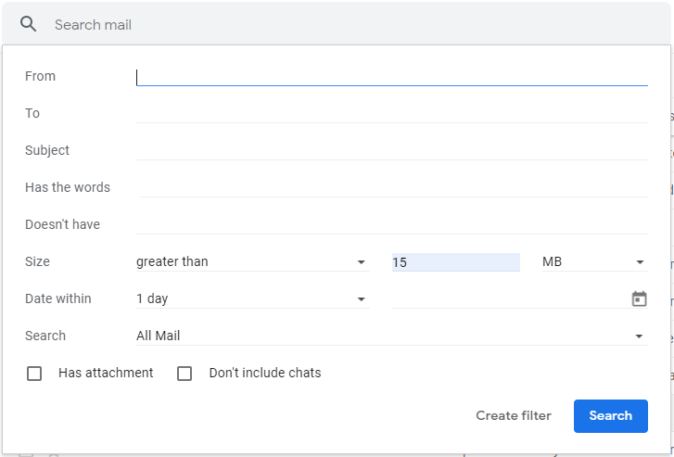
This view here is much easier to work with than the Google One auto-clean view. At a glance, you’ll have a pretty good idea of which messages you might want to keep and which ones you can safely torpedo based solely on the senders.
Check the boxes next to the emails you want to delete, then click the garbage can icon in the row of icons at the top of the messages list.
You’ll then need “empty” the trash to truly clear out these messages, which in turn frees up the storage space. Click “Trash” in the left sidebar, then click the “Empty Trash now” link. You can also wait for 30 days: The trash will then automatically empty itself.
Delete old messages
Another good way to free up space is to simply delete old email you don’t need anymore.
Using the same drop-down from the search bar, set the “Date within” option to something like within one year of the second year since you first opened your Gmail account. That way, it’ll search backward a year and forward a year.
Notice that the search box says something like “after:2006/1/1 before:2008/1/2” now. You can manually adjust the before and after years to create a wider range for yourself.
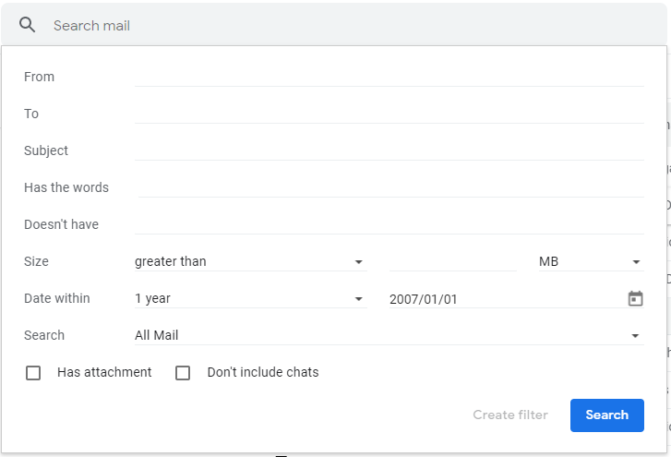
You probably don’t want to just wholesale delete every single email you got over a period of a few years, and it would take forever to go through all these messages to choose which ones to oust. But there’s a quick way to clear out messages that weren’t important to you back then and probably aren’t important to you now.
Up above the messages list where all the icons live, click the left-most icon that looks like a square with a dash in the middle of it. From the dropdown list, select “Unread” and it’ll put checkboxes in all the messages you never bothered to read way back when.
Delete those, empty the trash, and be on your merry way.
Combo time
You see where this is headed, right? Why not pull up old messages that have big attachments?
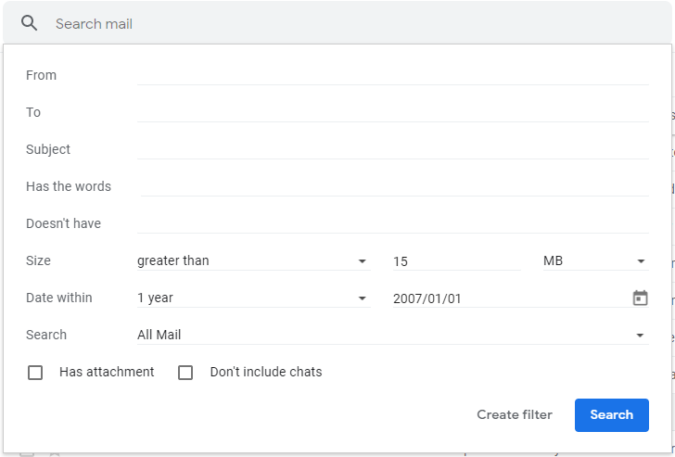
By now, you’re an advanced search expert. All you have to do is search for messages larger than 15 megabytes within a year of the second year you opened your account. Or whatever. Pick your own date range. You don’t need me anymore! Fly!
Delete ’em, empty the trash, you know the drill.
Bury the bulk mail
Unless you’re hyper-organized about email, hypervigilant about unwanted messages, or both, it’s possible that your inbox is a dumping ground for bulk mail you either never asked for or you don’t care about anymore.
A simple search for “unsubscribe” in the search box works wonders to turn up a giant collection of old newsletters, marketing emails, order updates, forum posts, and who knows what else. This search gives you quick access to clear out old and/or large messages, too. You can pull down the advanced search box and work your magic in there: The “unsubscribe” parameter will be filled in for you already.
This is also a good way to look over your recent messages to see all the email lists you’re on and unsubscribe from the ones you don’t find helpful. After all: For every message you prevent from coming into your inbox, it’s one fewer message you’ll need to clear out later.
Happy hunting!
Recognize your brand’s excellence by applying to this year’s Brands That Matter Awards before the early-rate deadline, May 3.
